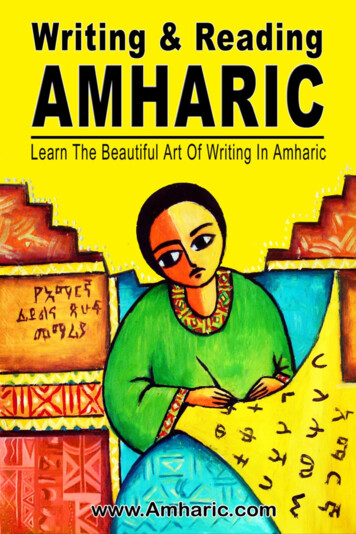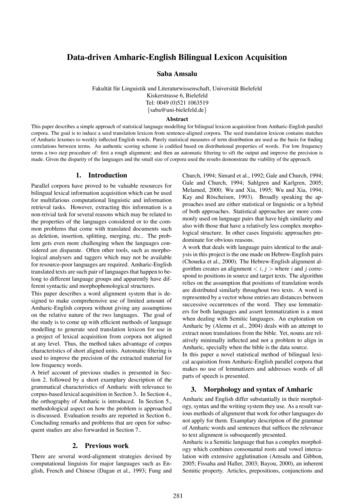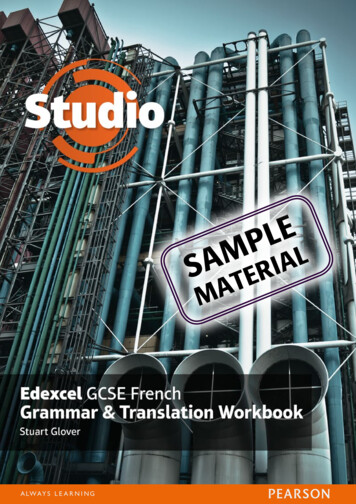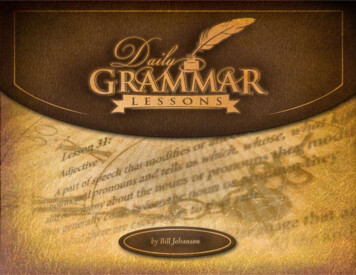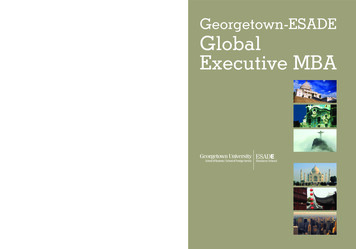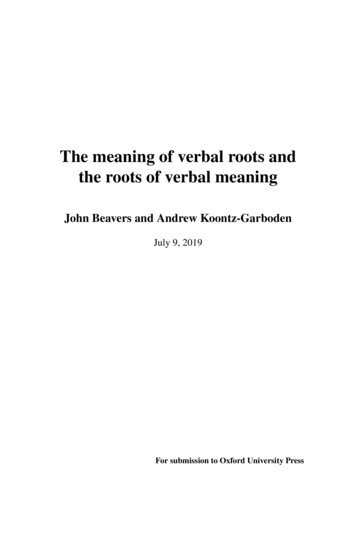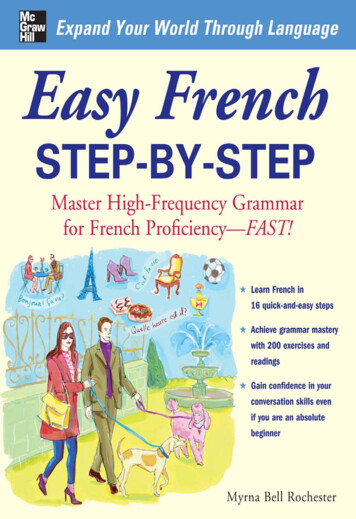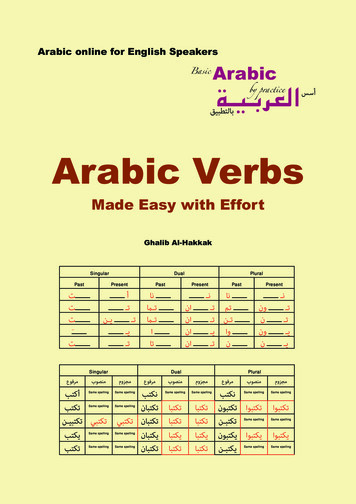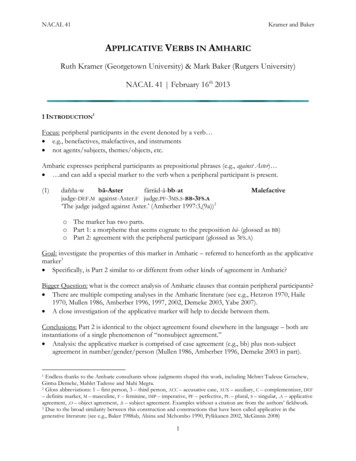
Transcription
NACAL 41Kramer and BakerAPPLICATIVE VERBS IN AMHARICRuth Kramer (Georgetown University) & Mark Baker (Rutgers University)NACAL 41 February 16th 20131 INTRODUCTION1Focus: peripheral participants in the event denoted by a verb e.g., benefactives, malefactives, and instruments not agents/subjects, themes/objects, etc.Amharic expresses peripheral participants as prepositional phrases (e.g., against Aster) and can add a special marker to the verb when a peripheral participant is e-DEF.M against-Aster.F judge.PF-3MS.S-BB-3FS.A‘The judge judged against Aster.’ (Amberber 1997:3,(9a))2Malefactiveo The marker has two parts.o Part 1: a morpheme that seems cognate to the preposition bä- (glossed as BB)o Part 2: agreement with the peripheral participant (glossed as 3FS.A)Goal: investigate the properties of this marker in Amharic – referred to henceforth as the applicativemarker3 Specifically, is Part 2 similar to or different from other kinds of agreement in Amharic?Bigger Question: what is the correct analysis of Amharic clauses that contain peripheral participants? There are multiple competing analyses in the Amharic literature (see e.g., Hetzron 1970, Haile1970, Mullen 1986, Amberber 1996, 1997, 2002, Demeke 2003, Yabe 2007). A close investigation of the applicative marker will help to decide between them.Conclusions: Part 2 is identical to the object agreement found elsewhere in the language – both areinstantiations of a single phenomenon of “nonsubject agreement.” Analysis: the applicative marker is comprised of case agreement (e.g., bb) plus non-subjectagreement in number/gender/person (Mullen 1986, Amberber 1996, Demeke 2003 in part).Endless thanks to the Amharic consultants whose judgments shaped this work, including Mehret Tadesse Getachew,Girma Demeke, Mahlet Tadesse and Mahi Megra.2 Gloss abbreviations: 1 – first person, 3 – third person, ACC – accusative case, AUX – auxiliary, C – complementizer, DEF– definite marker, M – masculine, F – feminine, IMP – imperative, PF – perfective, PL – plural, S – singular, .A – applicativeagreement, .O – object agreement, .S – subject agreement. Examples without a citation are from the authors’ fieldwork.3 Due to the broad similarity between this construction and constructions that have been called applicative in thegenerative literature (see e.g., Baker 1988ab, Alsina and Mchombo 1990, Pylkkanen 2002, McGinnis 2008)11
NACAL 41Kramer and BakerPlan Applicative markers in Amharic: an overview (Section 2) Applicative agreement is object agreement (Section 3) Preliminary analysis (Section 4) Conclusion (Section 5)2 APPLICATIVE MARKERS IN AMHARIC: AN OVERVIEWThere are two types of applicative markers in Amharic: bb Agr (see (1)) and ll Agr.(2)dañña-wlä-Aster färräd-ä-ll-atjudge-DEF.M for-Aster.F judge.PF-3MS.S-LL-3FS.A‘The judge judged in Aster’s favor.’ (Amberber 1997:4, (10a)) Benefactivell- is cognate with the preposition lä- ‘to/for.’They each correspond to two main kinds of peripheral participants (classified roughly bysemantic/thematic role).Table 1: Types of Participants Used with each Marker4bb5 Agrll AgrMalefactiveBenefactiveInstrumentGoal (e.g., return to, bring to, send to, sell to, explain to)6 Examples: malefactive (1), benefactive (2), instrumental (3), goal (4)(3)Aster bä-mät’rägiya-w mäskot t’ärräg-ätʃtʃ-ɨbb-ätAster.F with-broom-DEF.M window clean-3FS.S-BB-3MS.A‘Aster cleaned the window with a broom.’ (Amberber 1997:3, -ll-atYohannes.M book-DEF.M-ACC to-Aster.F return.PF-3MS.S-LL-3FS.A‘Yohannes returned the book to Aster.’ (Demeke 2003:70, (29))InstrumentalGoalbb- can also be used with certain locative phrases (Leslau 1995:428-429). The question ‘What should I do with thisbox?’ can be followed with lɨbs-ɨh-ɨn ask’ämmɨt’-ɨbb-ät clothes-your-ACC put.IMP-BB-3MS.A ‘Put your clothes in it’ (Leslau1995: 429). However, Leslau does not provide any examples with an overt phrase in the sentence corresponding to thelocative. The vast majority of the provided examples are from relative clauses. We set the locatives aside here, for theirlimited empirical scope, as does much previous work on Amharic applicatives (e.g., Demeke 2003). Locatives aregenerally a more rare type of applicative cross-linguistically.5 The marker bb can also be used with an existential copula to indicate deontic modality (with the sense of “it is on himto do ”); see Leslau 1995:430-4326 There is one major exception: the goal of the verb give cannot be referred to with an applicative marker, to the best ofour knowledge. In Demeke 2003:70-71, it is implied that if ll- is added to the verb referencing the goal argument of give,the argument becomes reinterpreted as a benefactive and the goal is understood as null. See Section 4.7 Some speakers prefer to assign accusative case to instruments.42
NACAL 41Kramer and BakerThe bb/ll and the agreement marker are inseparable (Mullen 1986:208). The bb/ll requires a following agreement marker.(5) (6)a. lä-Gɨrmafärräd-ä-ll-ätfor-Girma.M judge.PF-3MS.S-LL-3MS.A‘He judged in Girma’s favor.’b. *lä-Gɨrma färräd-ä-llNo AgrThe agreement marker also requires a preceding bb- or ll-.8*Yohannɨsmäs’haf-u-nl-Astermälläs-atNo -llYohannes.M book-DEF.M-ACC to-Aster.F return.PF-(3MS.S)-3FS.AIntended: Yohannes returned the book to Aster.(Demeke 2003:74, (37))The bb/ll Agr unit is generally optional.9(6)dañña-wlä-Aster färräd-äjudge-DEF.M for-Aster judge.PF-3MS.S‘The judge judged in Aster’s favor.’ (Amberber 1997:4, (10a))Benefactive (1)(7)dañña-wbä-Asterfärräd-äjudge-DEF.M against-Aster judge.PF-3MS.S‘The judge judged against Aster.’ (Amberber 1997:3,(9a))Malefactive (2)Summary: Two applicative markers:o bb Agr (malefactives, instrumentals)o ll Agr (benefactives, goals) The two pieces (bb/ll and Agr) are inseparable The bb/ll Agr unit is generally optionalThese facts are widely known and generally reported by all sources, from purely descriptivegrammars like Leslau 1995 to theoretically-oriented analyses like Yabe 2007.However, the properties of the applicative marker itself have been less thoroughly investigated. Is applicative agreement similar to or different from other kinds of agreement? Main question ofnext section!Since most of the applicative agreement markers are identical to object agreement markers (see Section 3), omitting thebb-/ll- sometimes leads to a grammatical sentence where the agreement marker is interpreted as agreeing with the theme,i.e., not with the peripheral participant.9 The bb/ll Agr is obligatory when the peripheral participant has accusative case.8(i)dañña-wAster-ɨn färräd-ä-*(ll-at)judge-DEF.M Aster-ACC judge.PF-3MS.S-(LL-3FS.A)‘The judge judged in Aster’s favor.’ (Amberber 1997:4, (10b))3
NACAL 41Kramer and Baker3 APPLICATIVE AGREEMENTWe have seen that the second component of the applicative marker in Amharic is a marker ofagreement with a peripheral äs-ä-ll-atYohannes.M book-DEF.M-ACC to-Aster.F return.PF-3MS.S-LL-3FS.A‘Yohannes returned the book to Aster.’ (Demeke 2003:70, (29))o It cannot agree with a non-peripheral participant, e.g., the theme the book.(9)*Yohannɨsmäs’haf-u-nl-Aster mälläs-ä-ll-ätYohannes.M book-DEF.M-ACC to-Aster.F return.PF-3MS.S-LL-3MS.AIntended: Yohannes returned the book to Aster.’The applicative agreement marker is almost identical to the agreement marker used for themes (10)and for the goal of the predicate give (11): glossed as e.g., 3FS.O(10)Almaz tämari-wa-nayy-ätʃtʃ-atAlmaz.F student-DEF.F-ACC see-3FS.S-3FS.O‘Almaz saw the female student.’Theme(11)Gɨrma lä-Almaz mäs’haf-u-nGirma.M to-Almaz.F book-DEF.M-ACC‘Girma gave the book to Almaz.’Goal of givesät’t’-atgive-(3MS.S)-3FS.OTable 2: Object Agreement Marker Paradigm ((10), (11))Singularst1 person-ññ2nd person-h (masc.)-ʃ (fem.)rd3 person-(ä)w, -t after [u] or [o], -ɨw after [ʃ] or [tʃ] (masc.)Plural-n-atʃtʃɨhu-atʃtʃäw-at (fem.)Table 3: Applicative Agreement Marker ParadigmSingularPluralst1 person-ññ-nnd2 person-h (masc.)-atʃtʃɨhu-ʃ (fem.)rd3 person-ät (masc.)-atʃtʃäw-at (fem.)o All cells of the paradigms are identical except for 3rd person masculine singular4
NACAL 41Kramer and BakerHowever, it has not been carefully investigated to what extent applicative agreement has themorphological, syntactic and semantic properties of object agreement in Amharic. A solid list of properties of the object marker have been collected and confirmed (Baker 2012,Kramer to appear).Now: run through those properties and see if the applicative agreement marker behaves the sameway as the object agreement marker.Preview: it does, and this is the key to analyzing applicative markers (applicative marker is composedat least partially of an object agreement marker)Terminological NB: I will refer to all markers that covary with person/number/gender as agreement Cover term for clitic doubling and phi feature valuation (two separate processes in theoreticalapproaches)Morphosyntactic PropertiesSame Position with respect to Verbal Stem: In clauses that contain a main verb and an auxiliary verb,the object agreement marker attaches to the main F.F-ACC 1S.S-look.for-3FS.O‘I am looking for the secretary.’-allä-huAUX.NONPAST-1S.SThe applicative marker displays the same behavior: it attaches to the main verb.(13)k’ut’t’äññamist-u hullɨgize mpered wife-his always3FS.S-shout-BB-3MS.A AUX.NONPAST-3FS.S‘His quick-tempered wife is always shouting at him.’ (Leslau 1995:427)The object agreement marker and the applicative marker share the same ‘slot’ or position in thecomplex multi-morphemic Amharic verb.Only One Marker Per Verb and Agrees with Highest Participant: Even when a clause contains botha theme and a goal for give, there can only be one object agreement marker. In (14), there are two internal arguments (female goal Almaz, masculine theme mäs’hafun ‘thebook’), but having two object agreement markers is ungrammatical.(14)*Gɨrma lä-Almaz mäs’haf-u-nsät’t’-at-äwGirma.M to-Almaz.F book-DEF.M-ACC give-(3MS.S) -3FS.O-3MS.O10Intended: Girma gave the book to Almaz.This verb is a phonologically acceptable string in the language so there is no phonological reason why two objectmarkers should not co-occur. Also, note that if the object markers are attached to the verb in the opposite order, theresult is still ungrammatical (*sät’t’-ä-w-at give-3MS.S-3MS.O-3FS.O).105
NACAL 41Kramer and Bakero The object agreement marker in such cases must agree with the goal, i.e., the higherargument.(15)Gɨrma lä-Almazmäs’haf-u-nsät’t’-atGirma.M to-Almaz.F book-DEF.M-ACC give-(3MS.S)-3FS.O‘Girma gave the book to rly, there can only be one applicative agreement marker per clause. In (16) and (17), there is both an instrumental and a benefactive, but having two applicativeagreement markers (or two entire applicative markers) is ungrammatical.(16)Two Applicative Agreement Markers (ll Agr Agr)*Gɨrma lä-Almaz yɨhonä dɨʤʤ bä-mät’rägiya-wt’ärräg-ä-ll-at-ätGirma for-Almaz some doorway with-broom-DEF.M sweep.PF-3MS.S-LL-3FS.A-3MS.AIntended: Girma swept some doorway with the broom for Almaz.11(17)Two Applicative Markers (ll Agr bb Agr)*Gɨrma lä-Almaz yɨhonä dɨʤʤ �ärräg-ä-bb-ät-ll-atGirma for-Almaz some doorway with-broom-DEF.M sweep.PF-3MS.S-LL-3FS.A-BB-3MS.AIntended: Girma swept some doorway with the broom for Almaz. The applicative agreement marker in such cases must agree with the higher of the two peripheralparticipants, in this case the benefactive (see McGinnis 2008).(18)Gɨrma lä-Almaz yɨhonä dɨʤʤ bä-mät’rägiya-wt’ärräg-ä-ll-at (*t’ärrägäbbät)Girma for-Almaz some doorway with-broom-DEF.M sweep.PF-3MS.S-LL-3FS.A‘Girma swept some doorway with the broom for Almaz.’In fact, the object agreement marker and the applicative marker cannot co-occur with each other aswell, strongly indicating that the applicative marker is a type of object marker.12(19)1112Applicative Marker and Object Agreement Marker*Almaz w-ɨbb-ätAlmaz house-DEF.M-ACC with-broom-DEF.M sweep.PF-3FS.S-3MS.O.BB-3MS.Intended: Almaz cleaned the house with the broom.13Putting the applicative agreement marker on the other side of ll results in a similarly ill-formed verb: *t’ärräg-ätɨ-ll-at.The object marker and the applicative marker co-occur in presentational constructions, e.g., yɨhä-w-ɨll-ɨh ‘here he is foryou’ and Almaz yɨtʃtʃ-at-ɨll-ɨʃ ‘here Almaz is for you.’ However, it is possible that the “object marker” in these examplesis agreement on the deictic marker, a different phenomenon from the verbal agreement markers discussed above.13 Putting the object agreement marker on the other side of the applicative marker still results in an ill-formed verb:t’ärräg-ätʃtʃ-ɨbb-ät-äw6
NACAL 41Kramer and BakerTrigger Same Morphological Process: Some necessary background: when a nominal phrase isdefinite and contains a relative clause, the definite determiner attaches to the verb within the ʒclothes C-steal-3MS.S-DEF.M child‘the child who stole the clothes’ (Leslau 1995:86)However, if the verb within the relative clause has an object marker, there is no determiner.(21) [wäre-w-ɨnyä-näggär-at]lɨdʒnews-DEF.M-ACC C-tell-(3MS.S)-3FS.O child‘the child who told her the news’ (Leslau 1995:85)In (21), the nominal is interpreted as definite but without any visible determiner.In my previous work (Kramer to appear), I have argued that the object marker is a clitic, i.e., a typeof pronoun. It thus has the category D(eterminer) (Postal 1969). The restriction seen in (21) can then be explained in terms of haplology: there cannot be twodeterminers in a row on the same stem.(22)Morphological Haplology of DStem – D1 – D2 Stem – D1(D1 Object Marker, D2 Definite Determiner)If the applicative marker also triggers haplology of D, this is evidence that it is the same (type of)marker as the object marker. And in fact, this is what we find.14(23)a. yä-hed-ɨn-ɨbb-ätmängädC-go.PF-1PL.S-BB-3MS.A route‘the route that we went on’b. S.A-DEF routeIntended: the route that we went onSemantic PropertiesSensitive to Specificity: The object agreement marker can only agree with specific nominals (Yabe2001, Haile 1970). The object marker agreement may agree with a specific wh-word like which student as in (24), butnot a non-specific wh-word who as in (25).(24)Almaz tɨnantyätɨñnaw-ɨn tämariayy-ätʃtʃ-ɨwAlmaz.F yesterday which-ACC student.M see-3FS.S-3MS.O‘Which student did Almaz see yesterday’?(23b) and similar examples were reported to be ungrammatical by a native speaker consultant, and are also claimed tobe ungrammatical in Appleyard 1996:151. However, Leslau 1995:430 reports that similar examples to (23b) aregrammatical, although the majority of his examples are free/headless relative clauses. The definite determiner in afree/headless relative clause may be sufficiently different from nominal definite determiners and pronouns so as not totrigger the haplology rule in (22) (see e.g., Caponigro 2002 on definite determiners in free relatives).147
NACAL 41(25)Kramer and BakerGɨrma tɨnantmänn-ɨn ayy-ä(*-w)Girma.M yesterday who-ACC see-3MS.S-3MS.O‘Who did Girma see yesterday?’The same goes for the applicative marker. It can only refer to specific peripheral participants.(26)lä-yätɨñña-wasetnäw Gɨrma F.F woman isGirma doorway-DEF.M-ACC C-sweep.PF-3MS.S-LL-3FS.A‘For which woman did Girma sweep the doorway?’(27)lä-man näw Gɨrma mägbiya-w-ɨnfor-who isGirma doorway-DEF.M-ACC‘Who did Girma sweep the doorway S-LL-3MS.ATriggers Emphasis: The object marker also triggers a poorly-understood semantic effect of emphasison the participant which it agrees with – most likely some kind of topichood. Reported in Haile 1970 and Demeke 2003, and confirmed in fieldwork(28)Almaz wAlmaz house-DEF.M-ACC with-broom-DEF.M sweep.PF-3FS.S-3MS.O‘Almaz cleaned the house with the broom.’ (Demeke 2003:91)Demeke (2003) reports a similar effect of emphasis on the participant which an applicative markerreferences.(29)Almaz bä-mät’rägiya-w bet-u-nt’ärräg-ätʃtʃ-ɨbb-ätAlmaz with-broom-DEF.M house-DEF.M-ACC sweep.PF-3FS.S-BB-3MS.A‘Almaz cleaned the house with the broom.’ (Demeke 2003:92)Table 4: Similarities between Applicative Agreement and Object AgreementSame position on the stemOnly one per verbAgree with highest argument/participantTrigger determiner haplologyOnly agree with specific participantsAssociated with a semantic interpretation of emphasisConclusion: It misses a generalization to say that applicative agreement and object agreement aretwo separate types of morphemes as is traditionally done in both descriptive and theoretical work in Amharic their phonology, morphology, syntax and semantics are nearly identical.Instead, we submit that applicative agreement and object agreement should be considered the samephenomenon: non-subject agreement markers in Amharic.8
NACAL 41 Kramer and BakerDifferent forms in 3rd person masculine singular allomorphy triggered by bb/ll (anotherconditioning factor in the already-existing rule for allomorphy in 3rd person masculine singularobject agreement markers)4 PRELIMINARY ANALYSISIn much of the data above, the entire applicative marker (bb/ll Agr) acts like an objectagreement marker. Same position on the verb Distribution is sensitive to specificity Trigger a topic-like interpretation Object agreement markers and applicative markers cannot co-occurTo capture these similarities, we propose that the applicative marker is a two-part agreement marker(Mullen 1986, Amberber 1996, in part Demeke 2003). Part 1: agrees with the case of the peripheral participant (benefactive/goal ll-,malefactive/instrument bb-) Part 2: agree with person/number/gender of peripheral participant (uses same endings as othernon-subject verbal agreement)Many Indo-European languages have pronominal clitics (i.e., agreement markers) that vary in case(e.g., Spanish, French, Greek and many Slavic languages). In these languages, case and person/number/gender are syncretic (the clitics do not have twopieces where one corresponds to case and one to person/number/gender).Table 5: Bulgarian Clitic Pronouns (Scatton 1984:147)SingularPluralPerson123123Dativemitimu (m.), ì (f.)niviimAccusative metego (m.), ja (f.)nivigi In Amharic, though, these two pieces are individually identifiable.Table 6: Amharic Nonsubject Agreement MarkersSingularPluralPerson1231Accusative/goal for give-ññ-h (m.), -ʃ (f.) -äw or –t (m.), -n-at (f.)Benefactives, Goalsllät (m.),llɨññ llɨh, llɨʃllɨnllat (f.)Malefactives, Instruments bbɨññ bbɨh, bbɨʃbbät (m.),bbɨnbbat wbbatʃtʃɨhu bbaʧʧäw
NACAL 41Kramer and BakerIf this is so, why does the case agreement look like a reduced version of a preposition? Baker and Kramer 2010 (cf. Hetzron 1970, Tremblay and Kabbaj 1990): all prepositions inAmharic are case markers. Independent justification in B&K 2010 (head-final languages that have prepositions aretypologically anomalous, if not nonexistent) So the similarity is now between case agreement (ll/bb) and case markers themselves, and thusno longer surprisingStill Preliminary: there are still some loose ends in the data. Why are there only three types of case agreement (null15, ll and bb) when there are many morecases (e.g., kä- ablative, wädä illative)? Why are object agreement markers, not applicative markers, used to agree with the Goal of give(see (11))?Closing the Loopholes: A Radical Suggestion It may be that the bb/ll portion of the applicative marker is agreement with some kind ofprepositional feature, not agreement with case per se. If there are only two such prepositional features, it explains why there are only two PPagreement markers (perhaps [ toward] ll, [-toward] bb) The Goal of give is a nominal with dative case, not a PP, so it does not trigger applicativeagreement.Advantages and conclusions: This analysis directly captures the similarities between the applicative marker and the objectmarker: they are different instantiations of the same phenomenon of non-subject agreement It also can account for the fact that the bb/ll looks like a reduced version of a preposition. Promising avenue for future work, perhaps by investigating the idea of agreement with P5 CONCLUSIONQuick Summary: The applicative marker in Amharic as a whole has many of the same characteristics of objectagreement markers, and partially phonologically resembles case markers. This suggests that the applicative marker is a two-part agreement marker that agrees separately incase and in person/number/gender with the same peripheral participant Support for (the spirit of) Mullen 1986, Amberber 1996, Demeke 2003 (in part)The Amharic paradigm raises the question of why accusative/dative doesn’t have a separate marker for case. In fact,Amharic’s close relative Chaha (Ethiosemitic) distinguishes the same cases with an overt marker for accusative/dative.(ii)a. yɨ-rəx-r-oBENEFACTIVE: ‘He sent something for them.’15b. yɨ-rəx-β-oMALEFACTIVE: ‘He sent something to their detriment.’c. yɨ-rəx-n-oACCUSATIVE/DATIVE: ‘He sends them.’3MS.S-send-CASE-3PL.O10(Banksira 2000:262)
NACAL 41Kramer and BakerCross-Linguistic Picture Substantially similar facts across Ethiosemitic (Chaha: Banksira 2000, Gumer: Völlmin 2006) Also found in other language families, e.g., Cushitic (Somali: Appleyard 1990) and Caucasian(Abaza: O’Herin 2001) To what extent can the analysis above be generalized to account for these cases?6 REFERENCESAlsina, Alya and Sam Mchombo. 1990. The syntax of applicatives in Chichewa: problems for atheta-theoretic analysis. Natural Language and Linguistic Theory 8. 493-506.Amberber, Mengistu. 1996. Transitive alternations, event-types and light verbs. DoctoralDissertation; McGill University.Amberber, Mengistu. 1997. The unergative-unaccusative distinction and the benefactive applicativein Amharic. Proceedings of the Twenty-Third Annual Meeting of the Berkeley Linguistics Society: SpecialSession on Syntax and Semantics in Africa. 1-13.Amberber, Mengistu. 2002. Verb Classes and Transitivity in Amharic. Münich: Lincom.Appleyard, David. 1990. Prepositional particles in Somali and their cognates in other Cushiticlanguages. African Languages and Cultures 3. 15-31.Appleyard, David. 1995. Colloquial Amharic: A Complete Language Course. New York: Routledge.Baker, Mark. 1988a. Incorporation: a Theory of Grammatical Function Changing. Chicago: University ofChicago Press.Baker, Mark C. 1988b. Theta-theory and the syntax of applicatives in Chichewa. Natural Language andLinguistic Theory 6. 353-89.Baker, Mark C. 2012. On the relationship of object agreement and accusative case: evidence fromAmharic. Linguistic Inquiry 43. 255-274.Baker, Mark and Ruth Kramer. 2010. “Prepositions” as case morphemes inserted at PF in Amharic.Paper presented at BCGL 5: Case at the Interfaces, Brussels, Belgium.Banksira, Degif Petros. 2000. Sound Mutations: The Morphophonology of Chaha. Amsterdam: Benjamins.Caponigro, Ivano. 2002. Free relatives as DPs with a silent D and a CP complement. In V. Samiian,ed., Proceedings of the Western Conference on Linguistics 2000 (WECOL 2000). Fresno, California:California State University.Demeke, Girma A. 2003. The clausal syntax of Ethio-Semitic. Doctoral dissertation, University ofTromsø.Haile, Getachew. 1970. The Suffix Pronouns in Amharic. Papers in African Linguistics 3. 101-111.Hetzron, Robert. 1970. Toward an Amharic case-grammar. Studies in African Linguistics 1. 301-354.Kramer, Ruth. To appear. Clitic doubling or object agreement: the view from Amharic. NaturalLanguage and Linguistic Theory.Lambdin, Thomas O. 1978. Introduction to Classical Ethiopic (Ge’ez). Ann Arbor, Michigan: ScholarsPress.Leslau, Wolf. 1995. Reference Grammar of Amharic. Wiesbaden: Harrassowitz.Marantz, Alec. 1993. Implications of asymmetries in double object constructions. In Sam A.Mchombo, ed. Theoretical Aspects of Bantu Grammar. Volume 1. Stanford, CA: CSLI. 113-151.McGinnis, Martha. 2008. Applicatives. Language and Linguistics Compass 2. 1225-1245.Mullen, Dana. 1986. Issues in the morphology and phonology of Amharic: the lexical generation ofpronominal clitics. Doctoral dissertation, University of Ottawa.Nakamura, Masanori. 1997. Object extraction in Bantu applicatives: some implications forminimalism. Linguistic Inquiry 28. 252-280.O’Herin, Brian. 2001. Abaza applicatives. Language 77. 477-493.11
NACAL 41Kramer and BakerPostal, Paul M. 1969. On so-called pronouns in English. In Roderick A. Jacobs and Peter S.Rosenbaum, eds. Readings in English Transformational Grammar. Waltham, Mass.: Ginn andCompany.Pylkkänen, Liina. 2008. Introducing Arguments. Cambridge: MIT Press.Scatton, Ernest A. 1984. A Reference Grammar of Modern Bulgarian. Columbus, OH: Slavica.Tremblay, Mireille and Ouadia Kabbaj. 1990. The internal structure of PPs in Amharic. In JohnHutchison and Victor Manfredi, eds. Current Approaches to African Linguistics 7. 167-178.Völlmin, Sascha. 2010. Benefactives and malefactives in Gumer (Gurage). In Fernando Zúñiga andSeppo Kittilä, eds. Benefactives and Malefactives: Typological Perspectives and Case Studies.Amsterdam: Benjamins. 317-330.Yabe, Tomoyuki. 2007. The morphosyntax of complex verbal expressions in the Horn of Africa.Doctoral dissertation, CUNY.Zeller, Jochen. 2006. Agreement and the EPP in Kinyarwanda applicatives. In Patrick Brandt andEric Fuss, eds. Form, Structure and Grammar. Berlin: Akademie Verlag. 275-295.APPENDIX: ALTERNATIVE ANALYSESThere are two main alternative analyses of the applicative marker (and of bb/ll in particular): bb/ll are incorporated prepositions bb/ll is an Appl(icative) headWe present some arguments against each alternative.Option 1: Incorporated PrepositionsThe morpheme bb is cognate with the preposition bä-, and the morpheme ll is cognate with thepreposition lä-.(30)bä- : by means of, by, through, in, into, at, on, against, etc. (Leslau 1995:602)lä- : to, for (Leslau 1995:601)This makes it tempting to analyze bb/ll as a kind of ‘verbal preposition’ that would combine withthe agreement marker. In fact, many analyses of applicative constructions in other languages propose that applicativemarkers are prepositions which incorporate into the verb during the course of a syntacticderivation (see e.g., Baker 1988ab, Nakamura 1997, Zeller 2006).However, there are some difficulties with treating bb/ll as if they are prepositions, especially asprepositions that are derived from or related to the peripheral participant PP itself.Limited to lä- and bä-: Amharic contains many other prepositions, but none of the others are used asapplicative markers.(31)kä- ‘from’sɨlä ‘about’wädä ‘towards’*kk Agr*sɨl Agr*wädd AgrThis is not a phenomenon that targets prepositions generally in Amharic.12
NACAL 41Kramer and Bakerll and bb Never Appear Separate from a Verb: The bb/ll is strictly a verbal morpheme. It cannot appear as a preposition on its own, even with a pronominal object (Mullen1986:80ff.).16(32)a. *ll-Gɨrma to-Girmac. lä-Gɨrma to-Girmab. *ll-ɨssuc. *ll-ät17d. lä-ɨssue. *lä-ätto-himto-3MS.Ato-himto-3MS.AMismatches: If ll/bb is a preposition, then we might expect it to bear some relation to thepreposition associated with the peripheral participant. In a preposition incorporation analysis, this relationship is even more directo The preposition moves from the peripheral participant onto the verb (and would have tobe pronounced in both its original and moved locations for Amharic).At first, this seems correct: bä- occurs with bb and lä- appears with ll. However, the peripheral participant can be associated with a different preposition from bä- or lä(33) Bɨrhanu sɨlä-gudday-umät’t’-a-bb-ätBirhanu.M about-business-DEF.M come.PF-3MS.S-BB-3MS.A‘Birhanu came for business (i.e., for the purpose of doing business).’ (Mullen 1986:269)Certain locative applicatives can be marked by a postposition.(34)[gänbo-w lay] mɨlɨkkɨt lät’t’ɨfɨ-bb-ätjar-DEF.M onlabelstick.IMP-BB-3MS.A‘Stick a label on the jar.’ (Leslau 1995:430)Taken individually, none of these arguments against a prepositional analysis of ll/bb areinsurmountable. For example, various theoretical enrichments can be proposed in order to have the prepositionincorporation analysis still work (e.g., proposing there is an additional ‘functional’ prepositionthat corresponds to ll-/bb- on each peripheral participant; Yabe 2007).However, taking these objections together, it seems like analyzing bb/ll as a preposition is not apromising direction to pursue.Option 2: Appl HeadAnother alternative would be to have bb-/ll- be the realization of a syntactic head Appl(icative) inwhose specifier the peripheral participant is merged (Demeke 2003 in part, Amberber 2002) similar to many Bantu languages (see e.g., Marantz 1993, Pylkkanen 2002, McGinnis 2008).This is distinct from other Semitic languages where pronominal agreement markers/clitics can appear on prepositions,e.g., Modern Hebrew, Lebanese Arabic, Ge’ez (Mullen 1986:123, Lambdin 1978:44).17 This is meant to be interpreted with the llät as a freestanding word/phrase, not attached to a verb.1613
NACAL 41(35)Kramer and BakerApplP3PPApplbä-Aster 3Appl -bb-However, applicatives in Bantu are very different from Amharic peripheral participants. In Bantu: the object agreement and the applicative marker do not form an inseparable morphological unit(e.g., they do not require each others’ presence) the applicative marker does not generally look like a preposition the peripheral participant can be passivized (not true for this construction in Amharic; Yabe
1 Endless thanks to the Amharic consultants whose judgments shaped this work, including Mehret Tadesse Getachew, Girma Demeke, Mahlet Tadesse and Mahi Megra. . M book-DEF.M-ACC to-Aster.F return.PF-3MS.S-LL-3FS.A 'Yohannes returned the book to Aster.' (Demeke 2003:70, (29))
